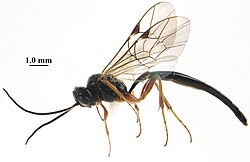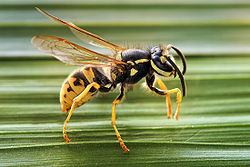Top Qs
Timeline
Chat
Perspective
Apocrita
Suborder of insects containing wasps, bees, and ants From Wikipedia, the free encyclopedia
Remove ads
Apocrita is a suborder of insects in the order Hymenoptera. It includes wasps, bees, and ants, and consists of many families. It contains the most advanced hymenopterans and is distinguished from Symphyta by the narrow "waist" (petiole) formed between the first two segments of the actual abdomen; the first abdominal segment is fused to the thorax, and is called the propodeum.[2] Therefore, it is general practice, when discussing the body of an apocritan in a technical sense, to refer to the mesosoma and metasoma (or gaster) rather than the "thorax" and "abdomen", respectively.[3] The evolution of a constricted waist was an important adaption for the parasitoid lifestyle of the ancestral apocritan, allowing more maneuverability of the female's ovipositor.[4][5] The ovipositor either extends freely or is retracted, and may be developed into a stinger for both defense and paralyzing prey. Larvae are legless and blind, and either feed inside a host (plant or animal) or in a nest cell provisioned by their mothers.
Apocrita has historically been split into two groups, Parasitica and Aculeata. Aculeata is a clade whose name is in standard use.[6] "Parasitica" is not a clade, as it is paraphyletic: the clade would contain the Aculeata.[7] "Parasitica" is therefore a rankless grouping in many present classifications, if it appears at all.[8] Parasitica comprises the majority of hymenopteran insects, its members living as parasitoids.[9][10] Most species are small, with the ovipositor adapted for piercing. In some hosts, the parasitoids induce metamorphosis prematurely, and in others it is prolonged. There are even species that are hyperparasites, or parasitoids on other parasitoids.[11] The Parasitica lay their eggs inside or on another insect (egg, larva or pupa) and their larvae grow and develop within or on that host. The host is nearly always killed. Many parasitic hymenopterans are used as biological control agents to control pests, such as caterpillars, true bugs and hoppers, flies, and weevils.[12]
Aculeata is a monophyletic group that includes those species in which the female's ovipositor is modified into a stinger to inject venom. Groups within Aculeata include the familiar ants, bees, and various types of parasitic and predatory wasps; it also includes all of the social hymenopterans.[13] Among the nonparasitic and nonsocial Aculeata, larvae are fed with captured prey (typically alive and paralyzed) or may be fed pollen and nectar. The social Aculeata feed their young prey (paper wasps and hornets), or pollen and nectar (bees), or perhaps seeds, fungi, or nonviable eggs (ants).
Remove ads
Extant families and superfamilies
Summarize
Perspective
The Apocrita contains a large number of families. Some traditional taxa such as the Parasitica (containing many families of parasitoid wasps) have been found on molecular analysis to be paraphyletic. Parasitoidism evolved once, and it is found today across most Apocritan families, though it has been secondarily lost several times. The phylogenetic tree gives a condensed overview of the phylogeny, illustrated with major groups. The sawflies are paraphyletic as the Apocrita evolved inside that group. The tree is not fully resolved.[13][14][2][9]
Cladogram of Apocrita after Peters et al.(2017)[9]
| Apocrita |
| |||||||||||||||||||||||||||||||||||||||||||||||||||||||||||||||||||||
* Suborder Apocrita
- Parasitoida
- Superfamily Ceraphronoidea
- Superfamily Ichneumonoidea
- Infraorder Proctotrupomorpha
- Superfamily Cynipoidea
- Superfamily Platygastroidea
- Superfamily Chalcidoidea
- Superfamily Diaprioidea
- Superfamily Proctotrupoidea
- Superfamily Mymarommatoidea
- Superfamily Evanioidea
- Superfamily Stephanoidea
- Superfamily Trigonaloidea
- Infraorder Aculeata
- Superfamily Apoidea (bees and sphecoid wasps)
- Family Ammoplanidae
- Family Ampulicidae (cockroach wasps)
- Family Astatidae
- Family Bembicidae (sand wasps)
- Family Crabronidae
- Family Mellinidae
- Family Pemphredonidae
- Family Philanthidae (bee wolves)
- Family Psenidae
- Family Sphecidae (digger wasps)
- Family †Angarosphecidae
- Family †Paleomelittidae
- Family †Temnogynidae
- Clade Anthophila (bees)
- Family Andrenidae (mining bees)
- Family Apidae (carpenter bees, digger bees, cuckoo bees, bumblebees, orchid bees, stingless bees, honeybees)
- Family Colletidae (yellow-faced and plasterer bees)
- Family Halictidae (sweat bees)
- Family Megachilidae (leaf-cutting bees)
- Family Melittidae
- Family Stenotritidae
- Superfamily Chrysidoidea
- Family Bethylidae
- Family Chrysididae (cuckoo wasps)
- Family Dryinidae
- Family Embolemidae
- Family Plumariidae
- Family Sclerogibbidae
- Family Scolebythidae
- Superfamily Formicoidea
- Family Formicidae (ants)
- Superfamily Pompiloidea
- Family Mutillidae (velvet ants)
- Family Myrmosidae
- Family Pompilidae (spider wasps)
- Family Sapygidae
- Superfamily Scolioidea
- Family Scoliidae
- Superfamily Tiphioidea
- Family Bradynobaenidae
- Family Sierolomorphidae
- Family Tiphiidae
- Superfamily Thynnoidea
- Family Chyphotidae
- Family Thynnidae
- Superfamily Vespoidea
- Family Rhopalosomatidae
- Family Vespidae (paper wasps, potter wasps, hornets, pollen wasps, yellowjackets)
- Superfamily Apoidea (bees and sphecoid wasps)
- Parasitoida
Remove ads
References
External links
Wikiwand - on
Seamless Wikipedia browsing. On steroids.
Remove ads


